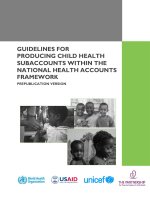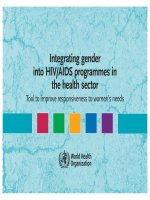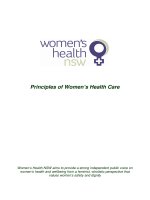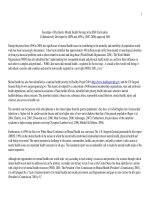Tài liệu Essentials of Psychiatric Mental Health Nursing in the BSN Curriculum: Collaboratively Developed by ISPN and APNA, (2007-2008) approved 5/08 ppt
Bạn đang xem bản rút gọn của tài liệu. Xem và tải ngay bản đầy đủ của tài liệu tại đây (71.03 KB, 13 trang )
1
Essentials of Psychiatric Mental Health Nursing in the BSN Curriculum:
Collaboratively Developed by ISPN and APNA, (2007-2008) approved 5/08
During the period from 1998 to 2008, the significance of mental health issues in contributing to the mortality and morbidity of populations worldwide has been increasingly documented. It has been identified that approximately 450 million people suffer from mental or neurological disorders
or from psychosocial problems such as those related to alcohol and drug abuse (World Health Organization, 2001). The World Health
Organization (WHO) has also identified that “understanding how inseparable mental and physical health really are, and how their influence on
each other is complex and profound… WHO (also states that) mental health – neglected for far too long – is crucial to the overall well-being of
individuals, societies and countries and must be universally regarded in a new light (WHO, 2001, p ix). ”
Mental health has also been identified as a national health priority by Healthy People 2010 () and the US Surgeon
General (). This report, developed by a consortium of 400 national membership organizations, state and territorial
health departments, and key national associations of State health officials, identified nine priority health indicators related to mental
health/substance abuse concerns. The priorities include: tobacco use, substance abuse, responsible sexual behavior, mental health, injury and
violence, and access to health care.
The mortality rate for persons with schizophrenia is four times higher than the general population; they have a fivefold higher risk of myocardial
infarction; a higher risk for cardiovascular disease and have higher rates of new-onset diabetes than that of the general population (Enger et al.
2004; Chafetz, et al. 2005; Chwastiak et al. 2006; Muir-Cochrane, 2006; Salokangas, 2007). Furthermore, the prevalence of the metabolic
syndrome is higher among patients receiving Clozapine (Lamberti et al. 2006; Mitchell & Malone, 2006).
Furthermore, in 1999, the first ever White House Conference on Mental Health was convened. The U.S. Surgeon General presented the first report
(DHHS, 1999) on the mental health of the nation in which the inextricably intertwined relationship between mental health, physical health and
well-being were noted. The report presented a challenge to the nation, communities, health care providers, and policy makers to take action as
mental health issues are important health concerns for all ages. This landmark report was an undeniable call to make the mental health needs of the
nation imperative.
Although the opportunities for mental health care world-wide vary according to each setting’s resources and priorities, the avenues through which
mental health needs must be addressed are at the primary, secondary and tertiary levels. Even as the United States has been identified as a nation
with a high level of mental health resources (WHO, 2001; The President’s New Commission on Mental Health [President’s Commission], 2003),
it is still plagued by a “lack of national priority for mental health and suicide prevention, and fragmentation and gaps in care (across the life span)
(President’s Commission, 2003 p 3)”.
2
Nursing’s efforts to provide safe and effective care gained important support from the Institute of Medicine’s (IOM) Report, Crossing the Quality
Chasm: A new Health System for the 21st Century (2001). The Report (2001) demands a reinvented, innovative, and improved delivery of health
care. Six specific aims were proposed for the needed changes that is the health care system must be: (a) safe, (b) effective, (c) patient-centered,
(d) timely, (e) efficient, and (f) equitable. The IOM Report (2001) also calls for changes in the environment to support the 10 rules for redesign to
include: (a) applying evidence to health care delivery, (b) using information technology, (c) aligning payment policies with quality improvement,
and (d) preparing the workforce. In 2003, the IOM issued another Report, Health Profession’s Education: A Bridge to Quality which includes 8
core elements for an interdisciplinary health care workforce (IOM, 2003; Huckshorn, 2007).
The Essentials of Psychiatric Mental Health Nursing BSN Curriculum were originally developed by the Education Council Task Force of the
International Society of Psychiatric Mental Health Nurses (ISPN) and presented for approval in April 2005. A Task Force of the American
Psychiatric Nurses Association (APNA) updated the document during 2007 and a collaborative Task Force of APNA and ISPN continued the
update in 2008.
The American Psychiatric Nurses Association (APNA) in collaboration with the International Society of Psychiatric Mental Health Nurses (ISPN)
recognizes and supports the importance of mental health to the overall well-being of each individual. As part of this understanding, ISPN and
APNA identifies that the task of promoting mental health is multifaceted. In addition to providing direct care, professional education, consultation,
combating stigmatization, improving access, furthering research, advocacy and policy development are each factors for improving mental health
care.
Because a comprehensive approach to mental health care is multidisciplinary and collaborative, Nursing has an integral role in affecting the
mental health of millions of people through the use of unique skills, and by nature of the numbers of nurses who interact with clients in a variety
of settings. The President’s Commission Report (2003), The World Health Report 2001 (2001) and the most recent Mental Health, United States,
2002 (Department of Health and Human Services [DHHS], 2004) identify that nurses play a key role in the delivery of mental health care at all
levels of intervention and that there is a need to improve and expand this workforce providing evidence –based mental health services and
supports.
As part of their leadership roles, APNA and ISPN have identified that the educational preparation for the practice of psychiatric nursing begins at
the pre-baccalaureate level (ANA, APNA & ISPN, 2007; DHHS, 2004). Communication and therapeutic interpersonal relationships are critical
components that must underlie all nursing skills.
The recommended curriculum in this document may not be implemented in just one course or one semester but rather that students be exposed to
the experiences and learning across the entire baccalaureate curriculum. This is specifically the case in which learning outcomes are across the
life span and across settings. In addition, there are clear indicators that mental health content and learning outcomes may also span across several
semesters. For example, experiences with families and or groups may not occur in P/MHN settings but may occur in pediatric, maternity, and/or
community as well as in acute medical/surgical experiences. Furthermore, patients with psychiatric disorders who have other physical health
problems are in fact treated in acute care medical/surgical settings which require that students and new BSN/RNs have the requisite skills to
provide competent care. The ANA, APNA and ISPN Scope and Standards of Psychiatric-Mental Clinical Nursing Practice (2007) address the
3
trends for an increased awareness of physical health problems in the mentally ill living in the community. It is quite clear that the
psychiatric/mental health nurse needs to be able to assess the physical component of the patient’s health. This is a major issue in the co-morbidity
area with issues like diabetes, hypertension and a number of other common disorders (Farnam et al., 1999; Getty & Knab, 1998; Huckshorn,
2007). This is not to suggest that P/MHN content and experiences should be completely integrated or diluted but to acknowledge again that all the
experiences would not be possible to acquire in one theory or one psychiatric nursing clinical course. Furthermore, there is a belief that
psychosocial content is the core for all areas of nursing; thus, areas such as therapeutic communication cannot wait until a specific P/MHN course.
The debate continues regarding the definitions of “learning outcomes" and “competencies”, that is left to individual academic institutions.
McCabe (2000) defines critical clinical competencies as “behavioral reflection of the epistemology of psychiatric nursing. They are the specific,
measurable behaviors that reflect and represent the standards for practice and identify the nursing actions that can be expected of all psychiatric
nurses” (p. 113). Even though our purpose is to consider competencies that prepare generalist nurses with competencies in mental health nurses
that are needed for practice, it is reasonable to consider that these competencies still reflect standards of practice and nursing actions required to
meet these standards as well. McCabe further asserts that the identified competencies must match practice realities. In determining competencies
in psychiatric mental health nursing skills for generalist education at the baccalaureate level, it would seem necessary as well that these
competencies match the realities of nursing education today. More recently, Huckshorn (2007) outlined eight core competencies of mental health
staff (registered nurses, psychiatric technicians and/or aides) must have in order to improve the quality of care and service delivery in mental
health settings (pp. 27-28). The revised Essentials of Psychiatric Mental Health Nursing in the BSN Curriculum does include those core
competencies.
Based on the results of a survey that Patzel, Ellinger, & Hamera (2007) conducted of APNA members who are nurse educators, the mean number
of hours for BSN programs represented in the survey was 80.26 hours. This raises the question of how to have competencies that meet the
required education purpose but are still feasible given the limitation of hours for the experience. Thus again, core competencies must be gained
throughout the nursing program but are not a substitute for the discrete body of psychiatric/mental health nursing. Required clinical hours in
specialty areas are regulated by the state Boards of Nursing and are beyond the scope of this document.
Given the critical role of nurses in all areas of health care, their ability to affect the emotional well being of clients regardless of the setting and the
need for exemplary mental health service delivery (informed by effectively prepared nursing professionals) the following curriculum is
recommended for implementation.
4
Essentials for Undergraduate Education in Psychiatric Mental Health Nursing (PMHN) **see definitions below
Core Nursing Content
1.
Growth & Development
Essential PMHN Content
a.
b.
c.
d.
2.
Neurobiological Basis of
Care Practices
a.
b.
c.
3.
Pharmacotherapeutics
and Basic Principles of
Pharmacology
a.
b.
Principles of cognitive, emotional, and
psychological growth with corresponding
developmental milestones
Recognition of major disorders occurring in
childhood/ adolescence
1. Mood disorders
2. Eating disorders
3. Conduct disorders
4. ADHD
5. Pervasive developmental disorders
6. Substance abuse/dependence disorders
Recognition of major disorders occurring in
adulthood
1. Mood disorders
2. Psychotic disorders
3. Personality disorders
4. Substance abuse/dependence disorders
5. Anxiety disorders
Recognition of major disorders occurring in
older age
1. Depression
2. Dementia
3. Delirium
Neuroanatomical and neurophysiological
basis of and relationship to observable
patient behaviors and symptoms of
psychiatric disorders
Neurobiological theories of etiology of
common psychiatric health disorders
Genetics and psychiatric disorders
Neurobiological basis of pharmacological
and somatic treatments
Major psychotropic agents for identified
psychiatric disorders that include:
1. Classification
a.
b.
c.
a.
b.
a.
b.
Learning Outcomes Defined as Clinical
Competencies
Demonstrate competent generalist
assessment of the developmental needs of
patients experiencing psychiatric disorders.
Recognize normative versus non-normative
behavioral patterns in terms of
developmental milestones.
Plan and implement and evaluate age
appropriate care for patients with psychiatric
disorders.
Demonstrate competent generalist
assessment skills with emphasis on mental
status and neurological functioning.
Apply neurobiologic knowledge to care
practices and patient teaching.
Articulate knowledge of the neurobiological
mechanism for various psychotropic
medications.
Evaluate effects of medications on patient,
including symptom abatement, side effects,
5
Core Nursing Content
Essential PMHN Content
c.
4.
Communication Theory
and Interpersonal
Relational Skills
a.
b.
5.
Clinical Decision Making
a.
b.
c.
d.
2. Action and expected effect
3. Side effects and toxicity
4. Potential interactions with other
medications and diet
Common alternative medicine approaches
used in the treatment of psychiatric disorders
1. Herbals, minerals, and vitamins
2. Other alternative treatments
Therapeutic interventions for patients,
families, and groups experiencing, or at risk
for, psychiatric disorders
Therapeutic use of self with patients,
families and groups experiencing, or at risk
for, psychiatric disorders
1. Appropriate affective and cognitive
responses to patients
2. Concept of professional boundaries with
psychiatric patients and appropriate use of
self disclosure
3. Communication with patients experiencing
common psychiatric symptoms such as
disorganized speech, hallucinations,
delusions, and decreased production of
speech
4. De-escalation of aggressive behavior
5. Suicide assessment techniques
Taxonomy systems commonly used in care
of psychiatric disorders
1. NANDA
2. DSM-IVTR and ICD-10
3. Omaha System
Evidence-based care principles for
psychiatric disorders
Use of outcome measurements to evaluate
interventions and care strategies
Principles of safety in various treatment
c.
d.
e.
a.
b.
c.
d.
e.
a.
b.
c.
d.
Learning Outcomes Defined as Clinical
Competencies
toxicity, and potential interactions with other
medications/substances.
Identify factors contributing to patient
non-adherence.
Teach patients to manage their own
medications including strategies to increase
adherence to prescribed therapeutic regimen.
Apply pharmacotherapeutic principles to the
safe administration of psychotropic
medications.
Demonstrate therapeutic use of self with
patients, families and groups.
Apply therapeutic communication techniques in
care practices with patients experiencing
common psychiatric symptoms including
disorganized speech, hallucinations, delusions,
and decreased production of speech.
Demonstrate group participation/leadership
skills.
Develop professional boundaries necessary
for professional care giving relationships.
Discuss strategies for safe management of
crisis situations that occur in various treatment
settings incorporating principles of therapeutic
communication and patient psychopathology.
Apply taxonomy structures to patient specific
situations including the development of nursing
diagnosis.
Identify signs and symptoms characteristic of
each major disorder.
Evaluate the degree of evidence-base
available to support common psychiatric
nursing actions.
Implement evidenced-based care for patients
with psychiatric disorders.
6
Core Nursing Content
Essential PMHN Content
e.
f.
g.
6.
Patient Care Roles
h.
a.
b.
c.
d.
e.
f.
g.
settings
Concepts of psychiatric crisis and common
intervention practices with patients
experiencing psychiatric crisis
Violence
1. Anger and aggression
2. Levels and types of violence expression
such as suicide, homicide, domestic
violence, child and elder abuse
Standard care practices of common
psychiatric disorders including:
1. Psychotic disorders
2. Mood disorders
3. Anxiety disorders
4. Personality disorders
5. Substance abuse/dependence disorders
6. Cognitive disorders
7. Eating disorders
8. Somatoform disorders
9. Family and community violence
Use of informatics in psychiatric nursing
Principles of teaching/learning theories as they
relate to patients with psychiatric disorders
including psychoeducational approaches
Principles of clinical care manager with
psychiatric patients
Principles of case manager with psychiatric
patients
Principles of patient advocacy with psychiatric
patients
Consumer advocacy groups
1. NAMI
2. NMHA
3. Local resource identification
Overlap of nursing roles with self-help models
of care including 12 step models
Principles of collaborative relationships with
individuals, families, consumers and advocacy
e.
f.
g.
h.
a.
b.
c.
d.
e.
Learning Outcomes Defined as Clinical
Competencies
Plan and implement nursing interventions
appropriate to patients needs that reflect
etiological factors and standards of nursing
care.
Prioritize crisis intervention care practices
with patients with psychiatric disorders.
Assess patient potential for violence including
suicide and homicide.
Develop and implement suicide prevention
strategies.
Demonstrate ability to effectively teach patients
experiencing psychiatric disorders and their
families.
Plan and evaluate for a continuum of care that
provides safety, structure, and support for
patients with psychiatric disorders.
Evaluate the continuum of care for a patient
experiencing a psychiatric disorder.
Refer patients and families to advocacy
organizations.
Assist patients to access self-help groups.
7
Core Nursing Content
7.
Health Care Settings
Essential PMHN Content
a.
b.
c.
d.
e.
f.
8.
Cultural, Ethnic, and
Spiritual Concepts
a.
b.
c.
d.
e.
9.
Health Promotion and
Illness Prevention
a.
b.
c.
d.
e.
f.
10. Concepts of Chronic
Illness
g.
a.
b.
c.
groups
Principles of inpatient care.
Principles of psychiatric care in emergency
department settings
Principles of community mental health
Principles of psychiatric home care
Relationship of acuity of care and patient
needs to the setting of care
Evolving care settings (e.g. primary care,
telecare and web-based)
Diversity
Cultural, religious, and spiritual beliefs
regarding mental health and illness
Cultural issues and spiritual beliefs as they
relate to psychiatric symptom expression
Cultural/racial/ethnic diversity and impact on
mental health care delivery
Resources for culturally/linguistically sensitive
PMH care
Concepts of mental health promotion and
illness prevention
Known risk factors of common psychiatric
disorders
Screening and referral for common psychiatric
disorders
International and national indicators on mental
health (e.g. World Health Report and
Surgeon General’s Report on Mental Illness)
Healthy People 2010 goals and objectives
Standardized screening and symptom rating
instruments
IOM Report and National Patient Safety Goals
Common adaptation and coping techniques
used to deal with severe and persistent
psychiatric disorders
Symptom management with those who have
serious and persistent psychiatric disorders.
Concepts of co-morbidity
Learning Outcomes Defined as Clinical
Competencies
a.
b.
c.
a.
b.
a.
b.
c.
d.
e.
a.
b.
Describe available treatment options and
community based resources.
Plan and implement care in diverse settings
including acute inpatient and community based
settings of care.
Analyze adequacy of care settings related to
patient acuity and needs.
Demonstrate competent generalist cultural
and spiritual assessment.
Provide culturally and spiritually competent
care within the scope of nursing that meets the
needs of patients from diverse cultural, racial
and ethnic backgrounds.
Describe populations at risk for psychiatric
disorders.
Evaluate the need for screening and referral for
populations at risk for psychiatric disorders.
Assess, plan, implement and evaluate
interventions related to mental health
promotion and illness prevention specific to the
needs of diverse communities.
Describe standardized screening tools used to
identify at risk groups.
Plan, implement, and evaluate preventive care
practices for patients at risk for, or
experiencing psychiatric disorders.
Establish and maintain therapeutic
relationships with individuals who have a
severe and persistent psychiatric disorder.
Assess common mechanisms of adaptation
and coping used by patients experiencing a
severe and persistent psychiatric disorder.
8
Core Nursing Content
Essential PMHN Content
d.
e.
11. Ethical and Legal
Principles
a.
b.
c.
d.
12. Vulnerable Populations
a.
b.
c.
13. Nursing Research
a.
b.
Symptom management with those who have
co-occurring chronic conditions (e.g. medical
conditions and psychiatric disorders and/or
substance abuse and psychiatric disorders).
Concepts of relapse, relapse prevention,
recovery and resilience
ANA Code of Ethics and patient rights
legislation
Standards of practice for PMHN
Least restrictive treatment approaches
Legal rights of psychiatric patients based on
voluntary versus involuntary treatment status
1. Duty to protect
2. Duty to report
3. Confidentiality
Principles and concepts of working with
vulnerable populations
Access to care
Health disparities in mental health care and
outcomes
1. Developmentally disabled
2. Elders and children
3. Special needs of diverse populations
4. Marginalized populations such as homeless
and jailed
Research related to psychiatric health nursing
and care delivery concepts
Concepts of evidence based practice
c.
d.
a.
b.
c.
a.
b.
a.
b.
c.
Learning Outcomes Defined as Clinical
Competencies
Plan, implement, and evaluate a relapse
prevention plan for patients experiencing a
severe and persistent psychiatric disorder.
Prioritize care strategies for patients
experiencing co-morbid health states.
Clarify personal values concerning working
with patients experiencing psychiatric
disorders.
Advocate for patients and families with legal
and ethical concerns.
Develop plan of care to address ethical and/or
legal concerns that promote individual integrity.
Recognize the multiple and complex care
needs of vulnerable populations.
Plan, implement, and evaluate care strategies
that protect the rights and dignity of vulnerable
populations.
Critically analyze research reports as a
research consumer.
Assist patients and families in interpreting and
evaluating research findings.
Utilize research findings in planning and
evaluating care practices.
9
**DEFINITIONS OF COLUMN HEADINGS
1. CORE NURSING CONTENT –.Evident in general baccalaureate nursing curricular content
2. ESSENTIAL MHPN CONTENT – Specific elements and core content for PMHN. For example, under pharmacology; it is assumed that the
psychotropic medications are essential
3. CLINICAL COMPETENCIES OPERATIONALIZED AS LEARNING OUTCOMES – Measurable student behaviors that reflect mastery
of the essential content and reflect the PMHN skills expected of a newly graduated baccalaureate prepared nurse.
Development of the “Essentials of Psychiatric-Mental Health Nursing in the BSN Curriculum” was a joint project of ISPN’s Education Council
and SERPN Division. Contributing members of the Education Council, chaired by Mark Soucy, were M. Kathleen Brewer, Cynthia TaylorHandrup, Emily Hauenstein, Charlotte Herrick, Jane Mahoney, Margaret (Peg) Marshall, Trudy Mulve and Katherine White. Contributing
members of the SERPN Division, chaired by Vicki Hines-Martin, were Anita Hufft, Catherine Kane, Sandra Nelson and Vicki Hines-Martin.
This document was approved by the ISPN Board of Directors in April, 2005.
Reviewed and adapted by the APNA Education Council Task Force for Undergraduate Nursing Competencies: Hilarie Price, Phyllis M. Connolly
and Brenda Patzel (2007)
Reviewed and recommended by a Joint Task Force, Phyllis M. Connolly (APNA), Charlotte Herrick (ISPN), & Mark Soucy (ISPN) (2/28/08- 5/08)
approved by APNA and ISPN Boards May 2008.
10
References
American Association of Colleges of Nursing. (1998). The essentials of baccalaureate nursing education. Washington, DC: Author
American Nurses Association, American Psychiatric Nurses Association, & International Society of Psychiatric Nurses. (2007). PsychiatricMental Health Nursing: Scope and Standards of Practice. ANA, APNA, ISPN. Washington, DC.
American Psychiatric Nurses Association (1998, August). Psychiatric – Mental health nurse roles in outcomes evaluation and management.
(Position Statement). Washington, DC: Author.
Barrera, C., Machanga, M., Connolly, P. M., & Yoder, M. (2003). Nursing care makes a difference: Application of the Omaha documentation
system. Outcomes Management, 7 (4), 181-185.
Carter Ferren, K., Kaiser Laux, K., O’Hare, P. A., & Callister Clark, L. (2006). Use of PHN competencies and ACHNE essentials to develop
teaching-learning strategies for generalist C/PHN curricula. Public Health Nursing, 23(2), 146 – 160.
Chafetz, L., White, M. C., Collins-Bride, G. & Nickens, J. (2005). The poor general health of the severely mentally ill: Impact of schizophrenic
diagnosis. Community Mental Health Journal, 41(2), 169-184).
Chafetz, L., White, M. C., Collins-Bride, G. Nickens, J. & Cooper, B. A. (2006). Predictors of physical functioning among adults with severe
mental illness. Psychiatric Services, 57(2), 225-231.
Chwastiak, L. A., Rosenheck, R. A., McEvoy, J. P., Keefe, R. S., Swartz, M.S., & Lieberman, J. A. (2006). Interrelationships of psychiatric
symptom severity, medical comorbidity, and functioning in schizophrenia. Psychiatric Services, 57(8), 1102-1109.
Connolly, P. M., & Elfrink, V. (2002). Using information technology in community-based psychiatric nursing education: The SJSU/NT project.
Home Health Care Management and Practice, 14 (5), 344 – 352.
11
Connolly, P. M., Mao, C., Yoder, M., & Canham, D. (2006).Evaluation of the Omaha System in an academic nurse managed center. Online
Journal of Nursing Informatics, 10(3) [online]. Available: />Elfrink, V. L. (1999, Winter). The Omaha System: Bridging nursing education and information technology. On-line Journal of Nursing
Informatics [On-line] 3(1) Available: />Elfrink, V., & Martin, K. (1996). Educating for nursing practice: Point of care technology. Healthcare Information Management, 10(2),
81 – 89.
Enger, C., Weatherby, L., Reynolds, R. F., and Walker, A. M. (2004). Serious cardiovascular events and mortality among patients with
schizophrenia. Journal of Nervous and Mental Disease, 192(1), 19-27.
Farnam, C. R., Zipple, A. M.,Tyrell, W., & Chittinanda, P. (1999). Health status risk factors of people with severe and persistent mental illness.
Journal of Psychosocial Nursing, 27(6), 16–21.
Getty, C. & Knab, S. (1998). Capacity for self-care of persons with mental illness living in community residence and the ability of their surrogate
families to perform health care functions. Issues in Mental Health Nursing, 19(1), 53-70.
Herrick, C A. & Bartlett, R. (2004). Psychiatric nurse case management: Past, present, and future. Issues in Mental Health Nursing, 25, 589-602.
Huckshorn, K. A. (2007). Building a better mental health workforce: 8 core elements. Journal of Psychosocial Nursing, 45(3), 24-34
Institute of Medicine. (2001). Crossing the quality chasm: A new health system for the 21st century. Washington, DC: National Academies Press.
Institute of Medicine. (2003).Health professions education: A bridge to quality. Washington, DC: National Academies Press.
Institute of Medicine. (2005). Improving the quality of health care for mental and substance use conditions: Quality chasm series. Washington,
DC: National Academies Press.
Kaiser Laux, K., Carter Ferren, K., O’Hare, P. A., & Callister Clark, L. (2002). Making the connections: Linking generalist and specialist
12
essentials in baccalaureate community/public health nursing education and practice. Journal of Professional Nursing, 18(1), 47-55.
Lamberti, J. S., Olson, D., Crilly, J. F., Olivares, T., Williams, G. C., Xin, T., Tang, W. Wiener, K., Dvorin, S., & Dietz, M. B. (2006). Prevalence
of the metabolic syndrome among patients receiving clozapine. American Journal of Psychiatry, 163, 1273-1276.
Wiener, K., Dvorin, S., & Dietz, M. B. (2006). Prevalence of the metabolic syndrome among patients receiving clozapine. American Journal of
Psychiatry, 163, 1273-1276.
Long, J. (2007). The institute of medicine report health professions education: A bridge to quality. Policy, Politics, & Nursing Practice,
4(4), 259-262.
Mallette, C. (2003). Nursing minimum data sets. In D. M. Doran (Ed.) Nursing-Sensitive outcomes: State of the science. (pp. 319– 53).
Sudbury, MA: Jones & Bartlett.
McCabe, S. (2000). Bringing psychiatric nursing into the twenty-first century. Archives of psychiatric nursing, 15, 109-116.
Muir-Cochrane, E. (2006). Medical co-morbidity risk factors and barriers to care for people with schizophrenia. Journal of Psychiatric and Mental
Health Nursing, 13, 447-452.
Martin, K.S., (2005). The Omaha System: A key to practice, documentation, and information management(2nd ed.). St. Louis: Elsevier.
McCabe, S. (2000). Bringing psychiatric nursing into the twenty-first century. Archives of psychiatric nursing, 15, 109-116.
McNeil, B. J. Elfrink, V. L. & Bickford, C. J. (2003). Nursing information technology, knowledge, skills, and perceptions of student nurses,
nursing faculty, and clinicians: A U. S. survey. Journal of Nursing Education, 42, 341-349.
Mitchell, A. J. & Malone, D. (2006). Physical health and schizophrenia. Current Opinion in Psychiatry, 19(4), 432-437.
National Council of State Boards of Nursing. (2006). Frequently asked questions about the 2007 NCLEX-RN Test Plan. Chicago, IL: NCSBN.
13
New Freedom Commission on Mental Health. (2003). Achieving the promise: Transforming mental health care in America. Final report. DHHS
Publication No. SMA-03-3832).
National Institute of Health. (2000). Healthy people 2010. U. S. Department of Health and Human Services.
Patzel, B., Ellinger, P., & Hamera, E. (2007). Tomorrow’s psychiatric nurses: Where are we today in providing student’s clinical experiences.
Journal of the American Psychiatric Nurses Association, 13(1), 53 – 60.
Salokangas, R. K. R. (2007). Medical problems in schizophrenia patients living in the community (alternative facilities). Current Opinion in
Psychiatry, 20(4), 402-405.
U. S. Department of Health and Human Services. (1999). Mental health: A report of the Surgeon General. Rockville, MD. Author.
U. S. Department of Health and Human Services. (2002). Mental health, United States, 2002. Author.
World Health Organization. (2001). The world health report 2001-mental health: New understanding, new hope. Author.









